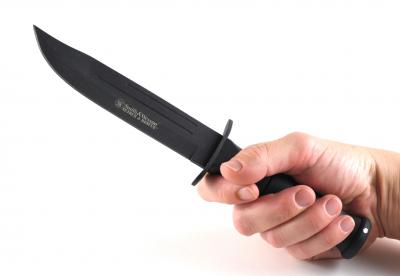 A survival knife is a piece of equipment that can literally save your life if all else fails. This tool can be used for hunting, building shelter, cleaning fish and even self-defense.
A survival knife is a piece of equipment that can literally save your life if all else fails. This tool can be used for hunting, building shelter, cleaning fish and even self-defense.
And for those looking to pick up a solid, all-around survival knife, the choices are plenty. While many of the survival knives being sold today are great quality tools, not all of them are perfectly designed for survival situations. So if you’re trying to buy the best knife for surviving in dire circumstances, these are the five features you don’t want on your survival knife.
Folding mechanism
The last feature you want on a survival knife is the ability to fold. A folder, while much more convenient, is also much more likely to break when used in survival situations. You want a knife that does not have moving parts or bits that can be easily broken. Even if it does have a lock, extreme pressure will sometimes break a knife. Instead, opt for a fixed-blade knife.
Serrations
Serrated and partially serrated knives are all the rage these days. While there are plenty of good uses for serrations on certain knives, a fully serrated blade is a bad way to go. Serrations are mainly good for cutting rope, among a few other specialized activities. Everything you will be doing in the wilderness would require a plain edge. Also, serrated blades are impossible to sharpen on the fly, so if your blade dulls while you’re trying to survive, you’ll be out of luck. Instead, go for the plain-edged blade.
Gut hook
It might make sense to try to pack all the features into your survival knife like a gut hook. Wrong. You want a simple blade that will not make doing some of the important tasks, like slicing things, more difficult. You would likely rarely if never need a gut hook in survival situations.
Long blade
Another common misconception is the bigger, the better. While you wouldn’t want to have a small two or three inch blade on your survival knife, any blade longer than 12 inches is overkill. An ideal blade length is between four and six inches long. That gives you enough blade to do heavy tasks, but not enough that it would prevent you from doing more detailed tasks.
Partial tang
There’s absolutely no reason for you to opt for a partial tang over a full tang. A tang, for those who don’t know, is bottom portion of a blade. The bottom of a full tang knife extends all the way to the bottom of the handle, while a partial tang only extends down some of the handle or is significantly smaller. This is important because the smaller the tang, the more chance it has of breaking under extreme pressure.




March 7, 2016 at 6:15 am
Here’s the original “Five things to look for in a survival knife” Imitation is the sincerest form of flattery: http://survivalcommonsense.com/video-five-things-to-avoid-when-choosing-a-survivalhunting-knifefeed/
April 15, 2016 at 1:02 pm
This is why I love Morakniv. It’s a simple yet durable and effective knife. The scandi edge makes it easy to sharpen on the go too.
April 26, 2016 at 4:12 am
My thoughts exactly
morakniv Best all around and inexpensive enough to have multiple
May 22, 2016 at 12:01 am
Good and knowledgeable information.
February 23, 2017 at 2:50 pm
Great information and solid advice.